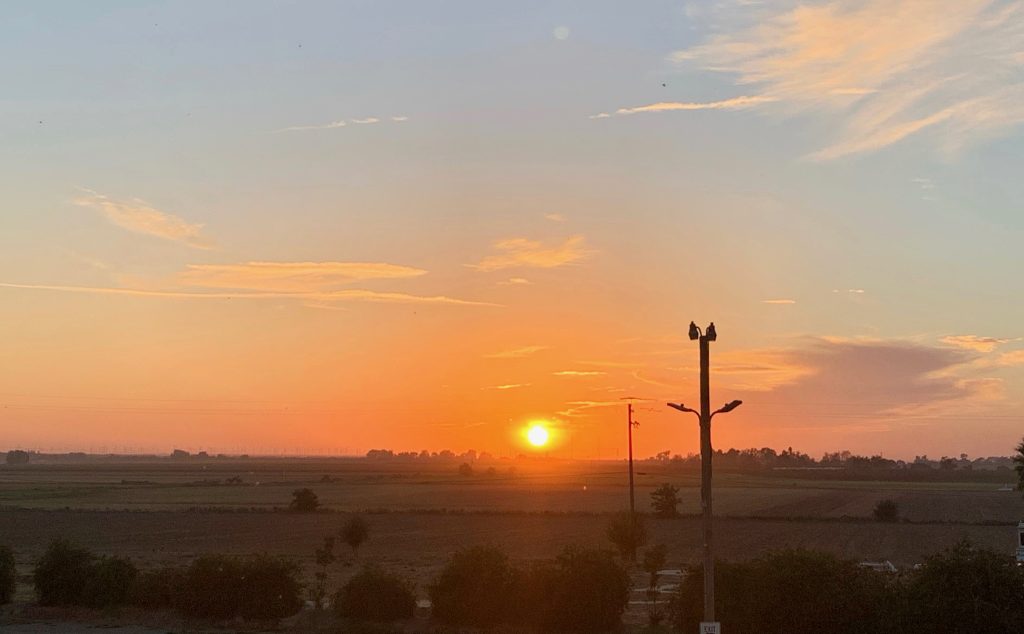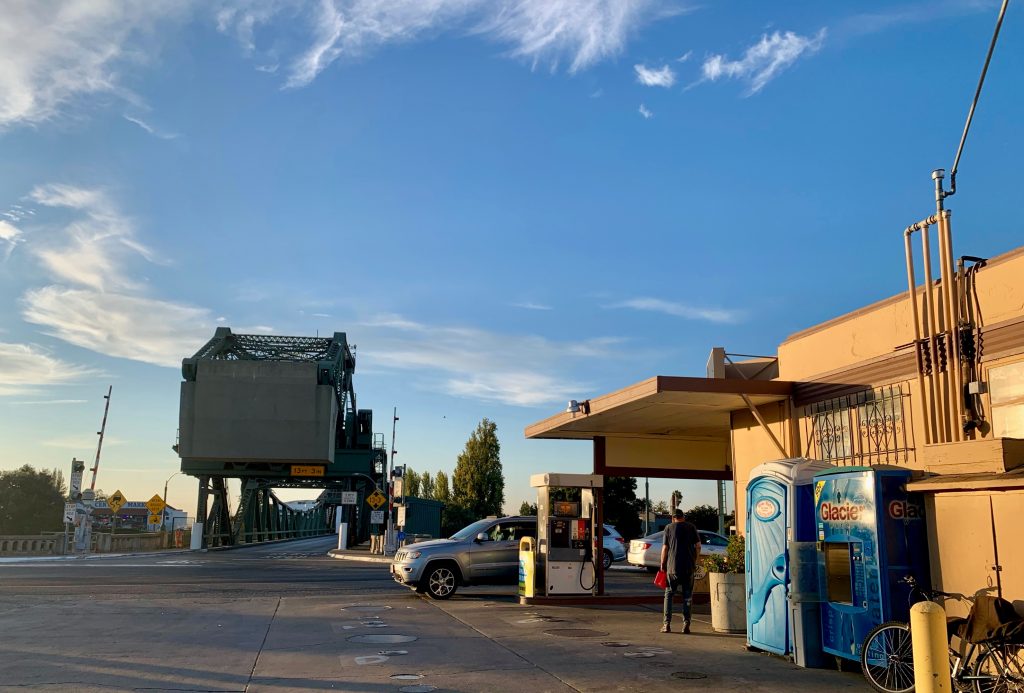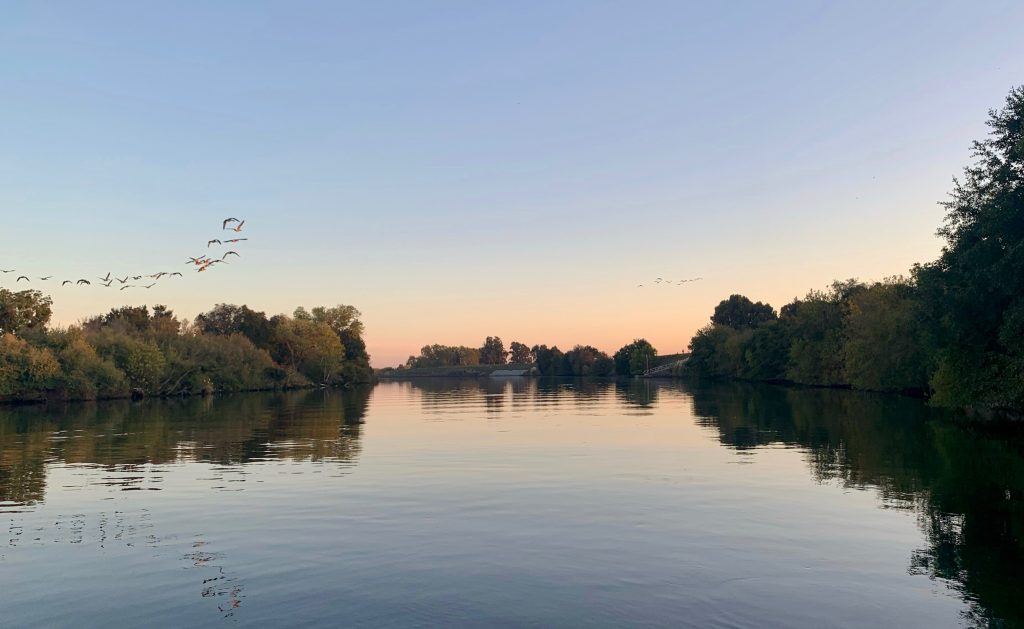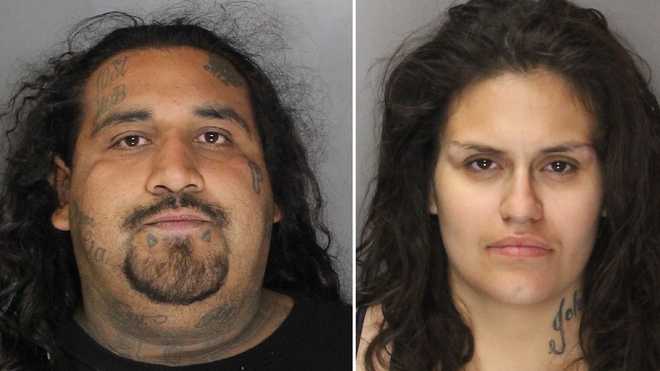Rosa Ventura had only been a volunteer firefighter for a year when she confronted the unimaginable.
Ventura belongs to a small group of emergency personnel looking out for the Delta community of Walnut Grove along the Sacramento River. These responders often deal with car wrecks happening on the narrow levees. They sometimes battle century-old wood structures erupting into flames. They’re the ones that get the call when someone is lost in the murky water’s reach. There’s a certain rhythm for Walnut Grove’s firefighters, but nothing could have prepared Ventura for the call she got around 7 a.m. on Aug. 26, 2019.
“It came in as a structure fire,” Ventura said on the witness stand in a Sacramento courtroom last week. “And on the radio, I heard our chief say it was a shed fire.”
Ventura’s team drove through the rising heat of red flag season as they headed down Isleton Road. Four miles past town, the weedy and wooded bends of the levee opened on the Bailey Ranch. The firefighters saw a bantam shed burning under the draping cover of a maple tree. They got out and then quickly started to perceive something else – a figure struggling near the pear orchard across the driveway.
“His body had smoke coming off it because the clothes on him had all burned off,” Ventura testified. “I’ve never encountered a burn victim like this before.”
The man had second-and-third-degree burns on 90% of his body. A park ranger had initially found him. Rushing over, the firefighters realized that, somehow, the charred man was still conscious. Assistant Fire Chief Mark van Loben Sels soon told Ventura to start talking to the victim while her co-worker rendered whatever medical aid he could. The man lay there shaking and nodding his head at the voices above him. Then Ventura and another firefighter tried speaking to him in Spanish. They suddenly made a connection. Ventura recalled in court that, despite his unfathomable pain, the man told her in Spanish that “they” had brought him into the shed, poured gasoline all over him and then lit him on fire.
Ventura kept the man talking as she worked to remember every detail about a crime scene that made little sense: Though the address doesn’t have immediate neighbors, the entire Bailey Ranch – including its now-scorching shed – is visible to all Delta traffic traveling down Isleton Road. It also has a house at the end of its driveway. In a way, the ranch is emblematic of a quiet openness permeating the flat, farming islands in its corner of the estuary.
The victim’s pain was beyond unbearable and the firefighters knew they’d have to drill a medication line straight into one of his bones. When they did, he screamed. Ventura told the court that, before sedating him, the man not only told her who he was – but he also named and described his attackers.
“They took him into that shed, and they set him on fire, and they burned him to-death,” Sacramento Deputy District Attorney Omar Singh told a jury last Thursday. Singh was speaking of Fabian Costila, the victim in the case.
“Mr. Costila repeatedly said, ‘I’m going to die. It hurts. I’m going to die,’” Singh went on. “And he was right. That is what happened.”
Death on a summer morning

Sacramento Sheriff’s Deputy Darryl Guzman was almost to the crime scene when he watched a medical flight go soaring over the Delta’s lapping sloughs and irrigation channels. Guzman pulled up to the ranch, seeing the victim was gone but the structure was still burning. He quickly ascertained that this wasn’t a simple arson investigation – it was something far more heinous. The deputy was told that in his last torturous moments of awareness, Costila had identified his attackers as Junior Chavez, whom he’d described in Spanish as “chunky” with big hair; and Martitsa Guerrero, whom he’d told the firefighters had dark hair and thick-rimmed glasses.
He was also notified that Walnut Grove’s assistant fire chief had seen a disabled truck on the side of Isleton Road that might be involved. Guzman began studying a trail of burned clothes that went from the decimated shed out to the pear orchard.
Last week, on the witness stand, Singh handed Guzman a silver paint can brought from evidence storage. Pulling on a black glove, Guzman opened it. He peered inside at the singed remnants of fabrics that had burned off Costila’s body.
On the day of the incident, Guzman was quickly joined by more deputies and investigators. They were mainly from the Sacramento Sheriff’s Office – except one. He was California Parole Agent Christopher Palwick. Based in Contra Costa County, Palwick had noticed around 7:43 a.m. that the ankle bracelet for a parolee he was monitoring altered “a master tamper.” The term basically means that the bracelet was cut, disabled or somehow destroyed. Palwick checked a digital map and saw that the last ping was around Tyler Island in the Delta. The agent drove out to that area to search for his parolee. As Palwick approached the coordinates he was following on Isleton Road, he ran straight up to the perimeter of a major crime scene. He got out and told a Sheriff’s deputy that one of his charges might be in the area.
The parolee in question was 27-year-old Martin “Junior” Chavez.
Driving to the crime scene from the opposite direction was Sacramento Sheriff’s homicide detective Robert Peters. As Peters passed the curtaining blue oak trees along the river, he spotted a mysterious white pickup that was backed jaggedly into the levee’s tangled weeds and wild grapes. Last week, Peters testified that it was a white Ford FI50 that had been ditched about 200 yards from the crime scene. Nearby the Ford, Peters saw a pair of jeans and a ripped tank top strewn behind the brush. Later, when the truck was searched, Peters located a silver stainless-steel knife, Fabian Costila’s cell phone and a bloody polo shirt with two stab marks in it. The truck’s back cab had blood stains, too. It would not be long before an autopsy of Costila’s body revealed that he’d been stabbed twice in the corresponding areas of his chest were the cuts where left in his shirt. Additionally, the medical examiner determined that Costila had suffered significant head trauma from being repeatedly pummeled, to the point of having a brain-bleed.
“He was beaten, he was stabbed, and then he was stripped almost naked before he was taken into that shed,” Singh told jurors. “And that was so the fire would get faster to his skin.”
While searching around the truck, Detective Peters had also spotted a pair of bolt-cutters. They helped tell the story.
“There was a master-lock to the gate to the property,” Peters testified of the Bailey Ranch, “and that lock had been cut and was on the ground.”
Later that afternoon, Peters was searching along a stretch of the Sacramento River when he caught sight of three individuals, basically in the middle of nowhere, wandering along the levee. Peters could tell that they were soaking wet from being in the water. The Sheriff’s office immediately detained the trio.
They turned out to be Chavez, Guerrero and a man whose street name is “Chongo.” All of them professed to not understand why they were being hand-cuffed. Their story was that they were drenched from a fresh swim in the river. Singh noted in court that the three had jumped into the water right at the moment they could hear the Sheriff’s dogs barking in the distance.
The Three and the One

Canvassing businesses across the Delta’s islands, investigators eventually found video surveillance from a Walnut Grove gas station that caught their attention. The place is a local staple called Delta Food and Gas. It stands on the edge of town about four miles north of the Bailey Ranch. At 7:05 a.m., its interior security camera had captured Martitsa Guerrero wandering in casually – almost leisurely – as she struck up a drawn-out conversation with the attendant. Eventually, after a few customers came through, Guerrero paid for some fuel.
While Guerrero was mulling around, the station’s exterior camera was pointed directly at the bed of a white Ford F150 parked along a pump. During the trial, Singh walked the jurors through a play-by-play of what that footage depicted: It shows Chongo, wearing a green construction worker’s jacket, hanging around the Ford’s tailgate. People walk by him. Chongo pays little attention. Chongo ultimately walks over to let Junior Chavez out of the back of the cab. The truck rocks a little as he does it. Detective Peters testified that this Ford had a so-called “suicide door” in its back cab, which is hinged from the rear and only allows a passenger to exit if someone releases them from the outside.
Singh argued that the video shows a possible commotion in the back of the truck before Chavez got out.
Jurors continued to watch the video-feed, framing Guerrero as she came outside and started pumping gas. Then, Chongo can be seen walking up to her and reaching his hand out with a large juice bottle. Guerrero pulls the nozzle out, filling the small container with gasoline. The trio then packs into the truck again as they drive onto River Road, a route with a nearby intersection for Isleton Road.
After Chavez, Guerrero and Chongo were taken into custody, Sheriff’s investigators wrote search warrants for every phone they recovered in the case. The detectives could see that around 3 a.m. on the morning of the crime, two calls were made between the man who’d been burned alive, Costila, and the woman whom Peters had arrested near the water’s edge, Guerrero. This indicated Costila agreed to meet up with the group that morning because it was Guerrero who called: She, it turned out, was someone the victim knew well.
As Costila lay dying by the pear orchard, firefighters had urgently tried to keep him talking. That’s when Costila fought through the unimaginable agony overtaking him and identified Junior Martinez and Martitsa Guerrero as his assailants.
Firefighter Rosa Ventura kept pushing him for details.
“I asked him what happened, and he said he was out with a couple of people and someone had poured gasoline on him and set him on fire,” Ventura recounted for the jury. “I asked him who did it, and he said, ‘Junior.’”
Ventura re-lived talking to the victim about Guerrero, too, explaining from the stand: “He said, ‘That fucking bitch comes around, but I don’t pay attention to her.”
Costila then muttered something to the effect of, “He thinks she’s my girlfriend, but she’s not my girlfriend. She’s causing me all kinds of problems.”
Ventura asked for him to keep telling her about the people who’d done this. She testified that, while tremoring and struggling to breathe, Costila said in Spanish that they were “some dudes – some fuckers. They hate me! They hate me!”
Concluding her memory, Venture ended with the last words she’d exchanged with a man who would soon be gone.
“He kept asking me if he was going to die,” she said. “We’re not supposed to answer that question, so I just told him, ‘Let’s not think about that.’ … We asked him if there was anything else he needed to say before we were going to put him to sleep, to try to give him some comfort, and he said, ‘I have a daughter.’”
Entanglements

Given the ankle bracelet saga, Sacramento Public Defender David Lynch had a seemingly tall order when it came to arguing Junior Chavez wasn’t guilty of a horrendous crime. But Lynch didn’t go into that mission without a plan: That’s because his own investigators had unraveled a Gordian knot of relationships between everybody involved – all of whom lived in the central Delta near the cities of Antioch and Pittsburg.
A defense investigator learned that the third man at Bailey Ranch on that fatal morning – “Chongo” – had, or has, a savagely violent temper when it comes to jealous obsessions.
According to official evidence in the case, in 2020 Chongo attacked a man in Contra Costa County that he thought was involved with his ex-girlfriend, Dolores. He punched the man over and over, kicked him repeatedly and then threatened to kill him with a knife. Later, Chongo went after Dolores herself, putting a machete blade up to her throat. The following year, Chongo assaulted a different man over a different ex-girlfriend, battering that victim with an iron crowbar some 10 to 15 times.
Lynch advanced a theory in the trial that, at the time of Costila’s murder, Chongo believed Martitsa Guerrero was his girlfriend. He called one witness to the stand who recalled seeing the two holding hands in the days leading up to the crime.
Just two weeks before that, however, the victim had taken Guerrero on a romantic trip to Santa Cruz and Halfmoon Bay. This information came straight from Costila’s sister, Yolanda, who broke down in tears on the witness stand.
“This is just very hurtful, very hard,” she sobbed, “to understand how we got to this point.”
A photograph also emerged on Facebook of Costila cuddling with Guerrero on their trip – a photograph that many people could presumably see, including Chongo.
Lynch told the jurors that it was Chongo who should be standing before them, not his client Junior Chavez. The attorney strongly argued that the brutality involved in Costila’s slaying fits a psychotic pattern seen in Chongo’s other crimes.
“It’s personal, it’s violent and it’s out-of-nowhere,” Lynch stressed, “and that bears some relevance to this trial.”
But Singh had a quick rebuttal for Lynch’s “love triangle” theory: Sheriff’s detectives had discovered that, even if the victim was seeing Guerrero, he’d also been dating Junior Chavez’s ex-wife. Between that, and the fact that the victim told his sister that he had no real interest in Guerrero, Singh argued that there was plenty of direct motive for the two people literally named in the man’s dying breaths.
“He’s dating [Guerrero], then he’s giving her the cold shoulder while he’s dating [Chavez’s] ex-wife,” Singh observed.
An accused killer takes the witness stand

Throughout the trial, Lynch painted a picture of Chavez being a man who wouldn’t have deep thoughts on a relationship between the victim and his ex-wife. In fact, Lynch portrayed Chavez as a man who wouldn’t have deep thoughts on anything.
When Christopher Palwick, Chavez’s parolee agent, was on the stand, Lynch brought up a conversation he’d had with Sheriff’s deputies the morning they were searching for their suspect.
“Did you indicate to detectives that Mr. Chavez is not very smart and might attempt to go home?” Lynch asked the agent.
“I don’t recall saying that,” Palwick responded.
“But that is consistent with your opinion of him?” Lynch continued.
“No,” Palwick said.
While the agent was testifying about a conversation that happened three years before, court records indicate that he did in fact tell the Sheriff’s Office that Chavez is really stupid.
Next, Lynch called Dr. Lake Everett to the stand, a clinical neuro-psychologist who performed an evaluation on Chavez. Everett testified that the defendant’s overall I.Q. is 68.
“That falls within the level of an intellectual disability,” the doctor explained. “His verbal skills were ranked even lower.”
In a rare move, Lynch ultimately called Chavez himself to the witness stand. The public defender told Chavez to describe, in his own words, what happened on the day of the murder. Chavez testified that he was supposed to be working for his father’s landscaping business that morning, but he decided instead to meet up with Chongo, Guerrero and the victim.
“How did you end up in a white truck driving all over the Delta?” Lynch asked.
“I do drugs, you know, so I wanted to get high,” Chavez replied.
“What drugs?”
“Crystal.”
Chavez went on to say that the four of them were supposed to be “mail-boxing” on that early morning, expounding that this meant stealing random citizens’ mail and trading it to identify thieves for methamphetamine.
“And did you do that?” Lynch asked.
Chavez nodded, “Yes.”
Lynch asked Chavez why the group’s Ford began steering further away from the Antioch-Pittsburg area and into the rural spans of the North Delta.
“We were looking for places to get up on,” Chavez said flatly.
“And by that, do you mean you were looking for houses to steal from?” Lynch clarified.
“Yeah,” the other replied.
Chavez acknowledged that the prowlers had gotten gas in Walnut Grove before eventually finding themselves out at the Bailey Ranch. He said that he’d watched Chongo get out to cut the lock on the gate before Guerrero drove the Ford onto the property. Chavez claimed that he walked past the small shed – i.e., the crime scene – and headed for a larger structure that he was hoping to burglarize. Suddenly, he told the jury, he heard someone screaming.
“I though the owner had come out,” he muttered, referencing the house at the end of the driveway. “I looked, Fabian was on fire.”
“What did you do?” Lynch asked.
“I got scared – I panicked.”
“Did you leave with the other folks in the truck?”
“I did,” Chavez answered, “and I’m sorry for that. I wasn’t thinking.”
During cross-examination, Singh confronted Chavez with some basic questions.
“So, what did you come to Sacramento for?” he asked.
“To steal,” Chavez repeated.
“You’d never been to Sacramento before?”
“No.”
“Wouldn’t you agree that if you see someone on fire, someone you don’t have a problem with, the instinct is to help them?”
“I was scared,” Chavez said again.
“What were you scared of?”
“Getting caught – going to jail.”
“You see someone on fire,” Singh began, “and you’re scared of getting caught for an accident? … You just leave someone who’s on fire, because you’re scared of getting caught with a little bit of meth?”
“I wasn’t thinking,” Chavez offered.
Singh grew increasingly blunt with his questions, asking Chavez why he and his friends decided to go for a casual swim just up river from where they knew a man had just been set on fire; or why Chavez had instinctively cut off his ankle bracelet just minutes after the murder, given he’d never tampered with it before in the previous months of being on parole. Chavez began answering virtually every question with, “I don’t remember.”
Deliberations

In closing arguments, Lynch acknowledged to the jury, in so many words, that his client Junior Chavez is a drug-addled, thieving simpleton; but the attorney stressed this doesn’t prove he’s the merciless hand behind the lighter.
“Well, blow me down, a bunch of meth-heads are out stealing mail,” Lynch said in mock-shocked tone. “While leaving a man who’s on fire is awful, and somewhat unforgivable, running away like that is not a crime.”
Lynch told jurors that Chongo was the slayer, and that his client wasn’t equipped with the capacity to know what was coming next.
“He didn’t see what tensions were going on,” Lynch offered. “And I’ll tell you why: As Dr. Everett already informed you, he’s not savvy enough to pick up on those tensions … You don’t need to be sophisticated to tell the truth.”
Lynch also suggested that the jury shouldn’t be too quick to listen to the victim’s dying declaration, since Costila had a severe head injury, had methamphetamine in his blood and was – at that instant – enduring a searing level of pain that no one in the courtroom could fathom.
Guerrero’s own lawyer, veteran defense attorney Russell Miller, echoed some of those concerns.
“Don’t base your decision on sympathy,” Miller cautioned, alluding to some highly graphic – if not horrific – photographs that the jury was forced to look at of the victim’s burned body. “I watched you when those first pictures went up of Mr. Costila and, ‘Wow’ – it had an impact … We asked you all, can you be a fair juror?”
Russell then suggested that while Costila had named Guerrero as one of his killers, given their previous dating relationship, he might not have meant that in the literal sense.
“It’s not unreasonable to believe he named her because he felt betrayed by her,” Russell reflected. “That’s the mindset.”
Russell ended his closing argument by returning to Chongo. “Ms. Guerrero was nothing but a pawn for [Chongo],” Russell said. “This is his way of life. He’s a scary human being.”
Singh began his closing remarks with a quote from George Washington.
“Our founding father said that it’s better to offer no excuse than a bad one,” the prosecutor noted. “They all ran while Mr. Fabian Costila was engulfed in flames, trying to put himself out.”
Singh emphasized that despite the countless, catastrophic injuries Costila had, he was making perfect sense as he described exactly what happened to him; exactly how it happened; and exactly who did it. Singh recapped how many elements of Costila’s dying declaration had been verified and proven long after he expired by Sheriff’s detectives.
Singh motioned to the other lawyers. “They’ve been throwing up a lot of ‘what ifs’ and imagined scenarios – a lot of conspiracy theories,” he said. “And that’s to try to distract you.”
This morning, Sacramento County Judge Steve White gave the jurors their final instructions. They deliberated for roughly three hours before finding both Martin Junior Chavez and Martitsa Guerrero guilty of First-degree Murder, with a special allegation of using gasoline as the weapon. They’ll be sentenced next month.
Scott Thomas Anderson is also the writer-producer of the true crime podcast series ‘Trace of the Devastation’


Be the first to comment on "Blood and Fire: the saga of a grisly execution that shocked the Delta is finally revealed in court "